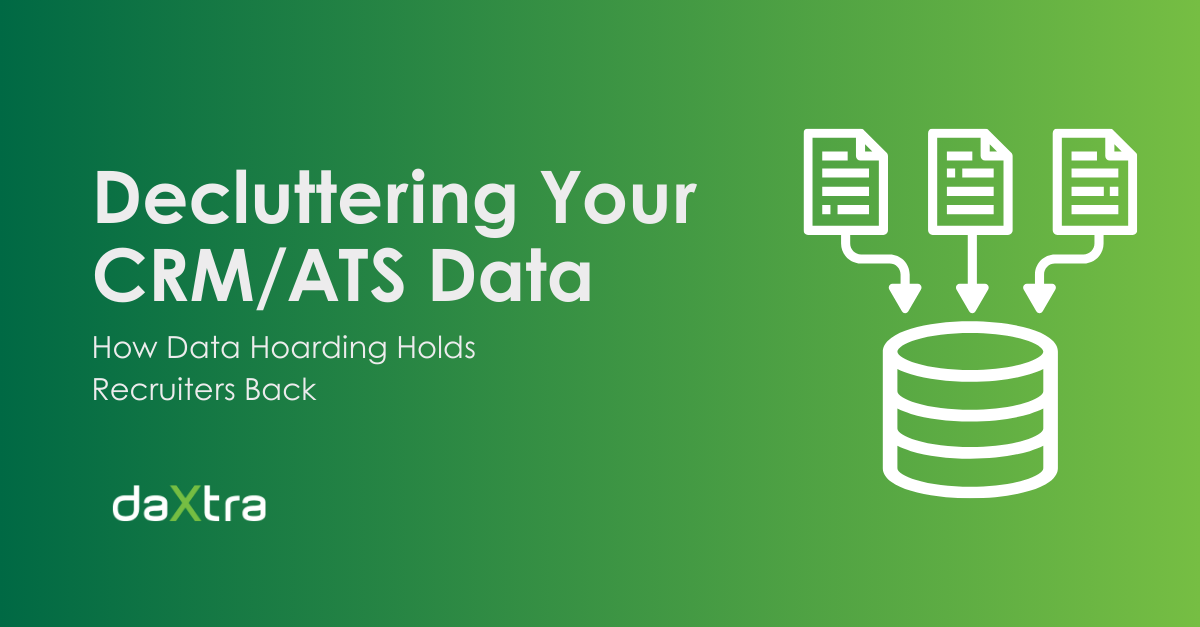Have you ever felt like you had more data than you knew what to do with? You’re not alone. With technology at our fingertips, it’s easier than ever to acquire massive amounts of unorganized data.
Whether it’s duplicate profiles, inaccurate data or an unorganized CRM or ATS, data hoarding can lead to massive headaches—especially for recruiters who rely on their internal database for critical candidate placements.
What is data hoarding?
Data hoarding is the practice of acquiring large amounts of electronic data or digital information, especially multiple copies of the same information, or more data than is useful or practical. It often becomes a problem when the volume of collected data is so large that it’s difficult or time-consuming to access specific data when you need it.
Data hoarding in recruiting is very common, and it can happen unintentionally. You could accidentally load bad data into your CRM or ATS, or over time accumulate entries with missing data, incorrect information, duplicate profiles or other manual data entry errors like misspellings, typos or abbreviations.
Why is data hoarding a problem?
Your internal database is a crucial component of your recruiting operations. Large amounts of outdated data poses several risks:
- Legal and regulatory concerns: if your database has a cumbersome amount of data, it becomes much harder to ensure your organization is complying with data privacy laws and regulations. Auditing for something like GDPR compliance can be much more labor-intensive if you’re hoarding data, and some regulations specify how long data can be kept.
- Security: a massive, unorganized database could be an appealing target for cybercriminals looking to target sensitive candidate information.
- Increased costs: storing large volumes of data can be costly. Plus, the larger your database is, the more expensive it is to maintain or clean it up in the future, so it’s best to ensure that data is actually useful to your organization.
- Accessibility challenges: when you’re hoarding data, it can be very difficult to find specific pieces of information when you need them. Inconsistencies in the data’s structure can make it so that your database isn’t optimized for searchability, which can also impact recruiter performance and the candidate experience.
"We realised many years ago that data was really, really important for us,” he said. “Data is a key factor in messaging candidates—so something we had to work out is ‘how does data get into our database?’ Getting data wrong means the whole quality of your database gets poorer and poorer. If that goes on, you’d be continually sending the wrong information to the wrong people at the wrong time.” – Brian Cunningham, Allen Recruitment
While it may seem daunting to address, there are ways to combat data hoarding and ensure that your organization sets up best practices to prevent it in the future. Doing so could be the difference between anywhere from 18-40% of your data entries containing errors and a well-oiled ATS/CRM that becomes your recruiters’ most effective tool.
Best Practices for Organizing Candidate Data
Collecting Data Intentionally
The first step to organizing your candidate data is thinking about why you collect data. Alex Barron, Director of Recruiting and Sales Operations at Innova Solutions, knows that intent in collecting data can make a big difference.
“When we’re using data to make better insights, we’re understanding the intent of our data,” she said. “What is the decision we’re trying to make, and why are we gathering the data to make it? What specific data do we need to look at and what format does it need to be in? These are all places to start, and things to look at before you go about collecting the data.”
Regular Data Cleaning
Regular data cleanups are essential to identify and correct inaccuracies in data.
“People often put off addressing data hygiene until they’re doing something huge, like upgrading from one instance of an ATS to another one… and while that’s great, there’s no better time to start evaluating your data than now,” says Danny Ashraf, Director of Sales at Monster.
By regularly reviewing data entries for accuracy, the date they were last updated and duplicate entries, you can develop a routine so bad data isn’t catching you off guard. It can also help to create simple, intuitive guardrails or processes that make it easy for teams to enter data, and ensure that candidate information is regularly updated. There are several ways to do this, but technology tools can be valuable in simplifying those processes.
Ensuring Data Quality
Recruiters wear many hats, so simplifying the data entry process can help reduce manual errors and ensure better-quality data.
Similarly, training teams on the impact of inaccurate data can help ensure that the end goal of clean data is top of mind during the data entry process. A few specific methods to do this include:
- Standardizing data entry procedures
- Holding meetings to provide training or education on the importance of data hygiene
- Providing incentives to regularly update candidate information
- Utilizing technology tools to streamline the data entry process
Implementing Effective Data Management Systems
Implementing good data management systems helps recruiters keep candidate info accurate, secure, and easy to access, making their job easier and more efficient.
A few ways to implement data management protocols are:
- Optimize data entry processes for your CRM or ATS by making the data entry process frictionless and intuitive
- Organize and categorize data by managing the ways you tag candidate data and ensuring consistency across your organization
- Automate data processes to reduce the risk of human error for manual data entry. Tools like Daxtra Capture can automatically add candidate information to your ATS or CRM, update existing records to eliminate duplicates and track sources.
Benefits of Data Hygiene and Avoiding Data hoarding
With good data hygiene, your database becomes more searchable and easy to use. Imagine how much easier it is to search for a “Scrum Master with 3 years of experience within 20 miles of Chicago” in a database with clear data entry protocols, compared to a database that’s accumulated candidate data for five years with no organization or automation.
Hygienic data can also lead to a better candidate experience. For example, Chris Wirt, VP of Sales - Americas at Daxtra, has seen the impact of poor data hygiene firsthand:
“I get emails, text messages and LinkedIn messages touting my experience as a life insurance rep and pitching me on a new role – 15 years after I was in that field,” he said. “Every one of those emails puts a bad taste in my mouth about the staffing firm, and if they reach out to me with something relevant later, I’m less likely to see it or at the very least, hesitant to engage with them.”
Better data hygiene means your candidate outreach efforts are more likely to be relevant—and more likely to earn a positive response. Hoarding data comparatively makes it more difficult to ensure that kind of accuracy.
“By bringing our database up to date, our matching is better and our candidate marketing is much better. Using Daxtra Capture gets candidates into our ecosystem, and Daxtra Search Nexus and vacancy match allow us to get a good set of candidates very quickly, without complicated technical knowledge.” - Brian Cunningham, Allen Recruitment
Say Goodbye to Data Hoarding Headaches
Data hoarding can have a negative impact on recruiting workflows. It can bring legal risks, security threats, high costs and decreased efficiency. But, by being intentional about data collection, regularly cleaning up your database and creating frictionless, efficient data entry processes, you can help keep your candidate info accurate and searchable. In the long run, this means that recruiters and candidates alike can have better experiences, and help your ATS or CRM become more of a helpful tool, and less of a headache.
To learn more about how Daxtra Capture can transform your ATS or CRM, visit our product page, or get in touch with our team to learn about your personalized use case.



